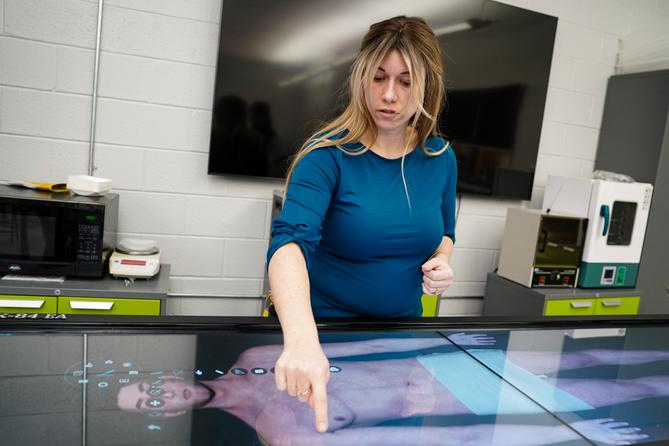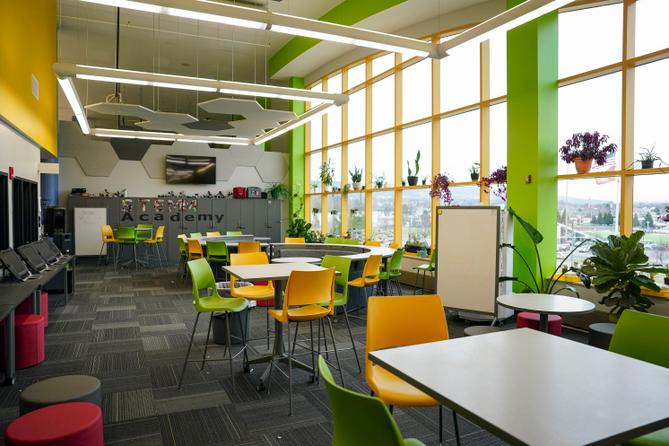SCRANTON — When Pennsylvania began sending hundreds of millions of dollars to its most underfunded public school districts last year, Erin Keating realized hers might finally get some breathing room.
Keating is the superintendent of Scranton School District. More than three-quarters of its 9,300 students qualify as low-income, and the district received the sixth-most supplemental funding in the commonwealth — $8.4 million in total.
All told, lawmakers sent poor districts across the state nearly $500 million, an unprecedented effort that came as a direct result of a court ruling that Pennsylvania’s school funding system was unconstitutionally inequitable.
Like many of the districts that received this new funding, Scranton has recently dealt with some tough budget cycles.
Pennsylvania’s Department of Education placed it on a fiscal watchlist in 2017 after a state audit found “serious financial instability,” and the agency eventually directed the district to work with a recovery officer to cut costs.
During recovery, Scranton closed an elementary school, reduced its electives, and got rid of its pre-K program. The district is still climbing out of that financial hole, a long process that Keating described as “not fun for anybody.”
So when the money — which lawmakers call “adequacy funding” — came, it made a difference there.
“You don't usually have a lot of money to play with for education and curricular opportunities,” Keating told Spotlight PA. This year, she said, she has been able to ask, “Is there a new class we want to offer? Is there technology we don't have that other districts have?”
But while Scranton and other districts say the money has helped with rising costs and maintaining programs for students, there’s no guarantee the state will keep approving it.
Gov. Josh Shapiro asked for another $500 million in adequacy funding for poor districts in his February budget pitch, and the Democrats who control the state House are on board. But the Republicans who control the state Senate say they have concerns.
Senate Majority Leader Joe Pittman (R., Indiana) told Spotlight PA in a statement that he wants to revisit the formula that distributes the money.
“As we look at the Governor’s proposal, 97% of his funding increase would go to 348 school districts and 3% would go to 152 school districts,” Pittman said. “This proposed breakdown raises valid questions of fairness.”
He said in the coming budget talks, “looking at how adequacy dollars are dispersed will remain a topic of conversation.”
This uncertainty, Keating said, has been a major hurdle when planning the district’s budget. Without consistency, the school district does not know if it can sustain new funding for academic programs or staffing.
“You kind of have to wait and see,” she said.
What does this money look like on the ground?
The $8.4 million Scranton School District received in adequacy funding accounts for nearly 4% of its total revenue in the 2024-25 school year.
According to administrators, it allowed the district to bring back previously cut art electives, hire new staffers focused on student mental health, invest in its Science, Technology, Engineering, Mathematics, and Medical — or STEMM — Academy, and maintain salaries and benefits for teachers in the district’s Cyber Academy, an online education option.
Maintaining the online school was the district’s biggest adequacy expenditure, at $5.2 million. Keating said it was an attempt to control a burden that public school districts in Pennsylvania are increasingly saddled with: costs associated with cyber charter schools.
Public districts in the commonwealth have to pay tuition for students within their borders who opt to attend charter schools. Many districts say high tuition rates put a significant burden on their budgets, especially as cyber charter enrollment has increased since the pandemic.
Keating said that she hopes the district stands a better chance at keeping students — and lowering its charter school burden — if it invests in its own online school.
“Everyone's seeing continued growth in the choice of cyber education, be it in internal programs or cyber charters,” she said. “It's not something that could be ignored.”
As Spotlight PA previously reported, Scranton wasn’t alone. Many districts used their adequacy money to either directly pay for growing charter or cyber charter tuition, or to fund competing, in-district online school or credit recovery programs.
But while it took up most of the new adequacy money, Scranton’s investment in cyber school wasn’t the only spending that made an impact.
Ninth grader Sara Williams is one of the students studying science, math, and more at Scranton’s STEMM Academy, and this year she got a chance to practice mock surgeries with her anatomy class’s virtual autopsy table.
Sara loves the program, her mother, Vivian Williams, told Spotlight PA. It sparked her daughter’s interest in college, she added.
"Back in eighth grade, my daughter was already talking about what she wanted to do after high school,” Williams said.

That’s the entire goal of the program, according to Keating: to give students a head start in breaking into fields with high demand and high pay.
STEMM Academy isn’t new. The district launched it in 2022 using federal pandemic relief funds, but after that money expired, Keating said the adequacy funding enabled the district to sustain the program without tapping into alternative revenue sources.
The academy initially served only 7th and 8th graders, but has steadily expanded and its oldest students are now in 10th grade. This school year, the district allocated approximately $780,000 in adequacy funding to support it, and STEMM Academy now employs 12 full-time teachers
Katona Miller, STEMM Academy’s program supervisor, noted that since the adequacy funding kicked in, district administrators have gotten a little less cautious about her requests for more staff, equipment, and resources. They have “at least been open” to requests, she said.
One of her recent purchases? Virtual reality glasses that will allow students to walk through the Acropolis or see the pyramids when studying ancient Greece and Egypt in history class.
These kinds of tools allowed the Scranton kids to keep up with “all the things the college kids were talking about and were doing” when they visited local universities, Miller said.
“We’re making sure we’re matching what industry is looking for,” she added.
Other adequacy spending focused on maintaining funding levels for general operating costs to free up budget space elsewhere.
For instance, $840,000 in adequacy funding is now going toward the salaries of kindergarten teachers and paraprofessionals like teacher’s aides. That created enough flexibility to bring back previously cut electives for kids in fifth through eighth grades, such as art, music, and physical education.
Keating and the school board also put $1.5 million toward existing guidance counselors’ salaries so they could hire three licensed professional counselors and two licensed social workers.
“I can't get you to sit in a seat and understand algebra if you're not in the right mental place to be able to do that,” Keating said of the move.
How did we get here, and where are we going?
The state legislature’s decision to give districts like Scranton supplemental funding can be traced back more than a decade to a 2014 lawsuit. The plaintiffs, a group of parents, public school advocates, and school district leaders, argued that the state's K-12 education funding system, in which districts rely substantially on property tax revenue, was so inequitable that it violated the state constitution.
Two years ago, Commonwealth Court sided with the plaintiffs, finding that Pennsylvania’s funding system was depriving students in low-wealth districts of their fair shot at a high-quality education. The judge ordered state lawmakers to find a solution.
After a statewide series of listening sessions, they came up with the concept of an adequacy gap — defined as the difference between the amount a district spends per student and the amount that district would need to spend to serve each child at an acceptable level.
This metric sets a baseline amount of per-student spending, then adds in additional spending based on a district’s student body and factors like poverty and level of English proficiency. If a district spends less than the resulting number, it misses its adequacy target.
Of Pennsylvania’s 500 school districts, lawmakers identified adequacy gaps in 348. The districts are located across the commonwealth, with roughly one-third in rural areas.
Last year, when the legislature and Shapiro allocated $500 million to start spending down those gaps, they also calculated the amount it would take to put all districts on adequate footing: about $4.5 billion.
The budget also allocated $32 million to a new supplement for 50 districts with high property tax burdens, along with broad funding increases for basic education and the commonwealth’s Head Start early education program.
Adequacy funds must be spent on expanding or maintaining educational programs or other student resources, such as mental health programs and English language classes. The adequacy funds need to be spent by the end of this school year, and the districts must report to the Department of Education how they used the funds.
After allocating their first year of funding, Keating and other administrators in Scranton are already thinking about the future.
Along with continuing Scranton’s attempt to control cyber charter costs and maintaining this year’s program expansions, her goals include offering more electives and hiring instructional coaches for specific subjects like reading and math.
But that’s going to depend on whether the state legislature decides to maintain adequacy funding.
State Rep. Pete Schweyer (D., Lehigh), who heads his chamber’s Education Committee and has championed adequacy funding, noted that despite comments questioning the fairness of the funding from Pittman, the state Senate majority leader, the formula passed last year with bipartisan support.
“It doesn’t mean everybody loves it,” Schweyer told Spotlight PA. “But it was a bipartisan bill.”
Education talks in Harrisburg often involve some horse-trading. Over the past several years Senate Republicans have repeatedly tried to work private school vouchers into the discussion, and just last week, the chamber’s Education Committee once again advanced a voucher bill.
Democrats have balked in the past, and Schweyer said as far as he’s concerned, this year will be no different.
“It ain’t the first time, and it ain’t gonna be the last time,” Schweyer said of the Senate’s voucher proposals. “But it’s not something I’m personally interested in supporting.”
Administrators like Keating are watching Harrisburg closely, and so are the public education advocates who took the state to court over school funding in the first place.
If they think lawmakers are shirking the order to fix Pennsylvania's unconstitutional school funding system, they warn they’ll go right back to court.
Dan Urevick-Ackelsberg is an attorney with the Public Interest Law Center who represents the people who brought the original funding suit. He has previously argued that even the state’s new supplemental funding scheme is too small and will be rolled out too slowly to truly put Pennsylvania’s schools on equitable footing.
But at the very least, he said, they need consistency.
“Districts need a timeline for funding,” Urevick-Ackelsberg told Spotlight PA. “Then people can really get into the long-term planning that they need to do.”
